on Vivint's website
Vivint Home Security System 2025: Tested and Reviewed
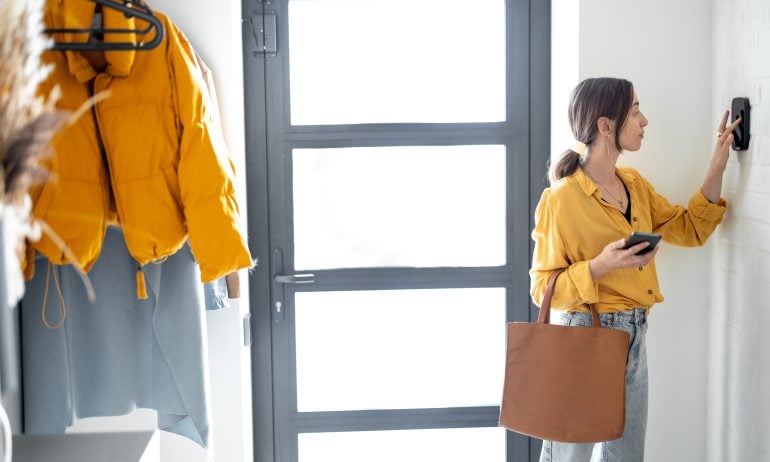
Some or all of the mortgage lenders featured on our site are advertising partners of NerdWallet, but this does not influence our evaluations, lender star ratings or the order in which lenders are listed on the page. Our opinions are our own. Here is a list of our partners.
Contents
Vivint’s home security system comes professionally installed, offering security coverage indoors and outdoors with several high-tech features. Among competitors, it stands out as a premium and user-friendly choice. It’s also the most expensive among systems we’ve reviewed — we tested a $2,600 setup — but for people who value ease of use, it’s worth the cost.
The professional installation took three hours, but we found the process to be easy and stress-free. The system is hardwired into the house, so it’s clear why DIYing isn’t an option. The installers even pulled an electrical permit to wire the video doorbell.
Deciding factors | |
|---|---|
One-time costs | $449.99 and up. |
Monitoring fees | $29.99 per month and up. Systems with smart home devices start at $39.99 per month and cost an additional $5 per month per camera. |
Installation | Included. |
Contract | Monitoring is month-to-month unless financing equipment. Contract terms can be up to 60 months (five years) and can come with 0% interest for qualified customers. |

How does Vivint work?
App and hardware

Screenshot of Vivint app on the Armed Stay setting. (Claire Tsosie.)
We tested a Vivint security system that included the following features:
A smart hub, which is a touchscreen tablet hardwired into the wall.
An indoor camera pro, which is plugged into an outlet and can be moved from room to room.
An outdoor camera pro and spotlight pro, which can monitor outdoor spaces; these devices come with a deter mode that uses sounds and flashing lights to scare off intruders.
Doorbell camera pro, a video doorbell that allows you to see and speak to people at the door through the Vivint app or smart hub.
A smart lock for the front door, which you can program to lock at certain times of day. You can lock and unlock it from your phone, the smart hub, using the keypad or with a physical key.
A water sensor, which alerts you when the surface it’s monitoring gets wet. This can help you catch leaks early.
A smoke and carbon monoxide detector, which alerts you when it senses smoke or carbon monoxide.
A keypad for arming or disarming the system remotely.
Motion sensors, which detect when something or someone is moving through a room.
Window and door sensors, which detect when windows or doors are opened.
Our installer first looked at our home to assess the number of windows and doors and the overall layout. Based on that, he made a recommendation about where to add sensors and where to install all the various components.
The system can be controlled by the smart hub, the keypad or the Vivint app on your phone. We ended up managing the system almost entirely from the mobile app, which made it simple to arm or disarm the system.
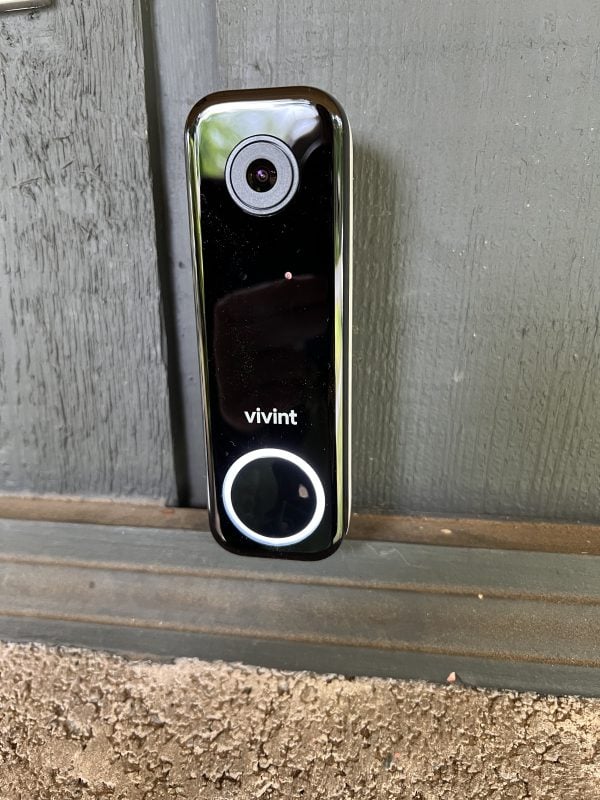
Doorbell camera pro. (Photo by Claire Tsosie.)
When an armed system is triggered, the smart hub alarm will set off warning beeps and calls to disarm. If it’s not disarmed within 30 seconds, the alarm will blare and the system will contact the Vivint dispatch center. The process varies depending on which type of alarm was triggered, but in general, the Vivint dispatch center will attempt to contact you first, then contact local police, fire department or emergency medical services.
Although you can do other things on the app and smart hub, such as view camera feeds or adjust sounds and settings, we mostly used them to arm or disarm the system.
Vivint offers smart lights, speakers and thermostats that can integrate with other smart home devices such as Google Home, Nest and Amazon Echo. (We didn’t test these integrations in this review.)
Installation
Our three-hour professional installation was time-consuming but not difficult or stressful. We only had to talk to the technicians for about half an hour at the end, when the installer explained how the system worked and walked us through setting up preferences and arming/disarming the system. The process also gave us more confidence that the products were set up correctly.
One issue we encountered: Not all products worked with our home. We wanted to test the smart thermostat, but weren’t able to because we didn’t have the wiring required. (Our thermostat is wireless; Vivint’s is hardwired.) If you’re keen on getting a certain item, you might want to talk to Vivint beforehand to make sure it’s compatible with your home.
Vivint equipment comes with a 120-day warranty for repair or replacement.
Alarms and notifications
The alarms on the Vivint system generally fall into three groups:
The smart hub alarm.
Deter mode on outdoor cameras.
Chimes triggered by indoor sensors.
You can also set up push notifications on the Vivint app. You don’t have to get notifications about every event your sensors and cameras pick up; you can select which events trigger notifications and which ones don’t.
Smart hub alarm
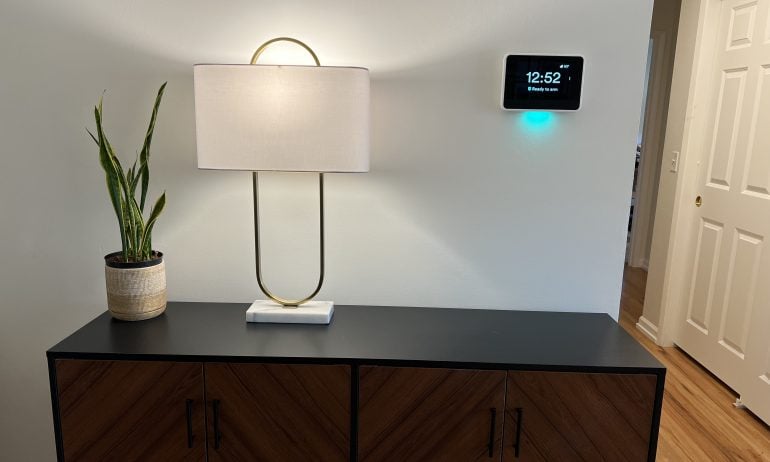
Smart hub. (Photo by Claire Tsosie.)
The smart hub, which is the wall-mounted tablet that comes with all of Vivint’s systems, has an alarm that’s loud and blaring. It’s triggered when the system is armed and detects certain events.
You can adjust what will and won’t set off this alarm by updating the settings, which can be easily done on the smart hub, keypad or app. There are three main settings:
Disarm: This setting ensures indoor and outdoor sensors don’t trigger the smart hub alarm.
Arm (Stay): This setting tells the system you’re in the house. The system’s alarm can be triggered by doors or windows opening, but not by movements throughout the home.
Arm (Away): This setting tells the system you’re out of the house. The system’s alarm can be triggered if any sensors detect certain events — for example, if a door is opened, if someone is moving through the house or if the smoke alarm is going off.
Deter mode
Deter mode is a setting on Vivint’s outdoor cameras designed to ward off package thieves and the like. When you put your outdoor cameras in deter mode, they’ll make a sound (a ding or whistle, for instance) when they sense someone lingering in the monitored area. You can adjust the sound type and get push notifications for certain events. The spotlight pro can be set up to flash, move or brighten its lights if triggered.
Indoor chimes
Vivint calls its customizable indoor alarms “chimes.” You can have motion sensors or window/door sensors set off one-time sounds, such as a ding or piano chord, when triggered, if you choose.
We preferred keeping the chiming to a minimum, but the settings could be useful if you have a large house and want kids or visitors to stay out of certain areas, for example. Even if you keep sensors on silent mode, the system detects events and you can view them from your app or smart hub.
What about false alarms?
With any motion-detecting system, there’s going to be some margin of error, and we occasionally noticed that with Vivint. Once, for example, a moth triggered the deter setting on the outdoor camera.
But the occasional misfires weren’t disruptive. They didn’t make the indoor alarm system start blaring, for instance. For us, they just resulted in more push notifications.
How much does Vivint cost?
There are two main costs associated with Vivint systems: the equipment costs and the monthly monitoring fees.
The monthly monitoring fees, which are required for all packages, start at $29.99. Systems with smart home devices or cameras start at a $39.99 monthly monitoring fee, which increases by $5 per month for each camera included in your system.
The equipment cost depends on the size of your home and your coverage needs. Our $2,600 setup provided good coverage for our 1,500-square-foot home. But for a larger space, or a place with more doors, windows and rooms, you might want more equipment.
Vivint offers bundles, all of which include a touchscreen smart hub, access to the Vivint app to control your hardware, a smart sensor, 24/7 professional monitoring, professional installation and a Vivint yard sign. The company often offers discounts, such as a free doorbell camera with system purchase. Here’s the equipment prices Vivint posts on its website:
Package | Equipment price | Items |
|---|---|---|
Security Starter Bundle | $449.99. | Vivint Smart Hub Control Panel, two door/window sensors and one motion sensor. |
Doorbell Security Bundle | $674.98. | Vivint Smart Hub Control Panel, four door/window sensors, one motion sensor and a doorbell camera. |
Safety & Security Bundle | $1,024.99 | Vivint Smart Hub Control Panel, four door/window sensors, motion sensor, smoke & CO detector, water sensor, doorbell camera and outdoor camera. |
You can customize any system by adding specific items, such as smoke detectors, smart locks and glass-break sensors, to an existing package. Financing through a monthly payment plan is available through one of the company’s three third-party partners.
Benefits of Vivint
High-tech features
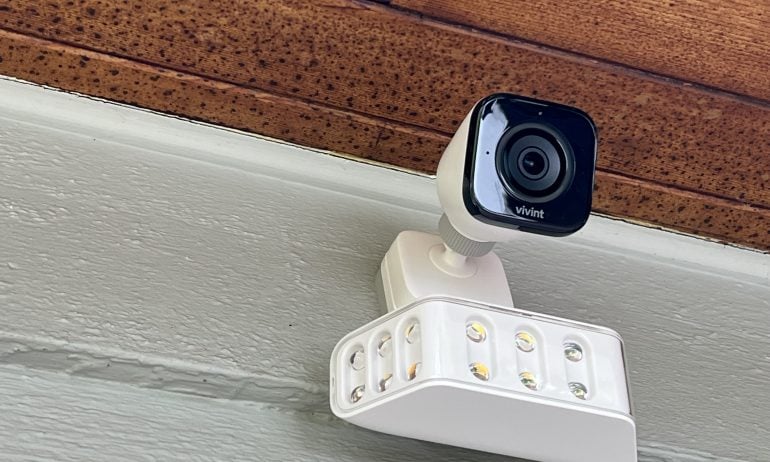
Outdoor camera pro and spotlight pro. (Photo by Claire Tsosie.)
Vivint offers certain standout features for home security equipment that other providers don’t have.
Our favorite feature was the deter setting on the outdoor camera pro and spotlight pro. We used the option that triggered flood lights and whistling when the system detected someone lingering in the detection area (our front yard, in this case) for more than 10 seconds. As a frontline security measure, it seemed very effective.
No record of breaches
Unlike several other home security providers, we could not find any public record of any security breaches.
Works reliably
Vivint worked reliably and predictably. When we changed settings in the app, the system updated right away. Because it’s hardwired, we didn’t have to worry about charging anything. We also found that the motion sensors, window/door sensors and other features detected events consistently.
We were also happy with how the cameras worked. The night-vision view made it easy to see what was happening when it was dark, and the wide frame provided great coverage. Cameras also picked up sounds, even from a distance. For example, the doorbell camera was able to pick up a conversation from across the yard, about 30 feet away.
Downsides of Vivint
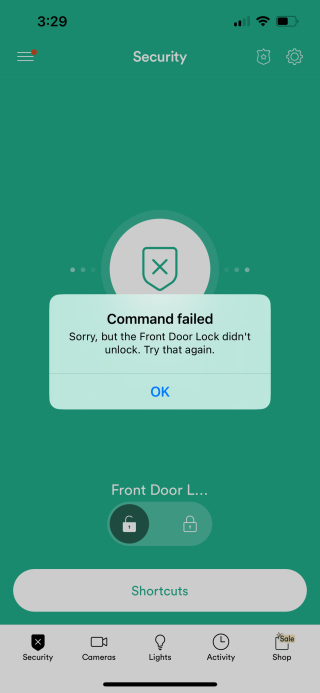
Screenshot of error message on Vivint app. (Claire Tsosie.)
Cost
Vivint is the most expensive home security system we’ve reviewed. Aside from the equipment cost, monthly fees start at about $30 per month for monitoring on a system with no cameras, and around $40 per month for a system with cameras or smart home equipment. For each camera added, that cost goes up by $5 per month. That means a three-camera system could cost more than $600 per year.
Minor lags (later fixed)
Although we really liked the smart lock for the front door, there were occasionally some lags when trying to unlock it from our phone. More than once, we got an error message saying it failed to unlock.
The good news: Vivint was responsive and helpful about fixing the issue. The company dispatched a technician, who determined there was a manufacturing defect in the smart lock. He replaced it with a new one and we haven't encountered any issues since.
Read more NerdWallet home security reviews based on firsthand testing:
Alternatives to Vivint
on SimpliSafe's website
on Money.com and Amazon.com
on NerdWallet
Dalia Ramirez, a lead writer at NerdWallet, contributed reporting to this review.
Methodology





